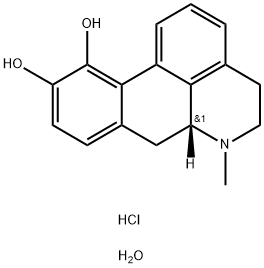41372-20-7

Product Name:
R-(-)-Apomorphine
Formula:
C17H20ClNO3
Synonyms:
R-(−)-Apomorphine hydrochloride hemihydrate
Inquiry
SAFETY INFORMATION
| Signal word | Danger |
|---|---|
| Pictogram(s) |
 Skull and Crossbones Acute Toxicity GHS06 |
| GHS Hazard Statements |
H301:Acute toxicity,oral |
COMPUTED DESCRIPTORS
| Molecular Weight | 625.6 g/mol |
|---|---|
| Hydrogen Bond Donor Count | 7 |
| Hydrogen Bond Acceptor Count | 7 |
| Rotatable Bond Count | 0 |
| Exact Mass | 624.2157777 g/mol |
| Monoisotopic Mass | 624.2157777 g/mol |
| Topological Polar Surface Area | 88.4 Ų |
| Heavy Atom Count | 43 |
| Formal Charge | 0 |
| Complexity | 374 |
| Isotope Atom Count | 0 |
| Defined Atom Stereocenter Count | 2 |
| Undefined Atom Stereocenter Count | 0 |
| Defined Bond Stereocenter Count | 0 |
| Undefined Bond Stereocenter Count | 0 |
| Covalently-Bonded Unit Count | 5 |
| Compound Is Canonicalized | Yes |
PRODUCT INTRODUCTION
description
Apomorphine Hydrochloride is the hydrochloride salt form of apomorphine, a derivative of morphine and non-ergoline dopamine agonist with high selectivity for dopamine D2, D3, D4 and D5 receptors. Apomorphine hydrochloride acts by stimulating dopamine receptors in the nigrostriatal system, hypothalamus, limbic system, pituitary gland, and blood vessels. This enhances motor function, suppresses prolactin release, and causes vasodilation and behavioral effects. Apomorphine hydrochloride is used in the treatment of Parkinson's disease and erectile dysfunction. In addition, apomorphine hydrochloride acts on the chemoreceptor trigger zone and is used as a central emetic in the treatment of drug overdose.
